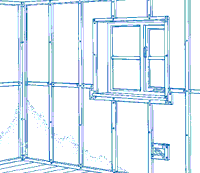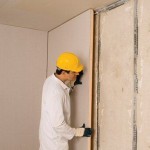The Blog
0 Comment
building material,Construction,Energy efficiency,Fitting,Plastering,Wall
Posted by: tgbuilders
Dry lining or drywall is used to describe a technique of covering a structure with a dry product which is attached to the structure. Traditionally surfaces were covered with a wet sand and cement render or plaster. Dry lining now refers mainly to covering internal walls with plasterboard with the plasterboard either stuck on the walls or fixed to a timber or steel frame which is attached to the walls.
Dry lining has several advantages over the wet finish in that it can be installed much more quickly especially in the case where it is stuck to the walls using a mix of plaster as an adhesive (note: this method is called “dot and dab”). The fact that dry lining is lighter than its wet counterparts means that the finished construction is lighter. In addition to what has been said, less moisture is introduced into the building structure. Dry lining partitions also means that properties can be changed to suit the changing needs of a family more quickly. In most cases, dry lining also allows greater use of insulating materials to keep the property warm for a longer period of time, something that is essential at a time where conservation of fuel and power are the most important global issues today.
Plasterboard can also be modified in a variety of ways provided that you don’t change the methods of construction too much. These modifications include the introduction of soundproofing, greater fire protection, moisture protection and anti-condensation features (by preventing warm getting into voids where it would condense on colder surfaces). Condensation is one of the most frequent causes of damage in properties and should be safeguarded against as often as possible. Finally a huge advantage of dry lining is that if it is properly prepared, it is considerably easier to decorate than plaster.
The disadvantages of dry lining are that it is more difficult to fix things to and it is easier to damage. It is also terrible at sound insulation when no sound proof material is inserted into the plasterboard. There are now a number of plasterboard fixings available and with a little forward planning when building a new plasterboard wall or partition, additional timbers can be inserted to carry the heaviest of loads.
Fig.1: timber framework inserted into Fig.2: builder inserting plasterboard
wall prior to plasterboard being inserted into wall with insulating material


Most people involved with DIY will turn to dry lining as a means of warming their properties and preventing the damage caused by moisture. In older houses with solid walls, the appearance of damp in the colder months is common which is most often caused by condensation . Condensation can be prevented by using simple ventilation methods to change the air in a room frequently.
For the longer term, the walls can be well insulated using dry lining by either:
- fixing timbers to the walls, fitting insulation between the battens and then fixing and decorating the plasterboard
OR
- placing dabs of plaster on the walls and pushing plasterboard onto them. The battening can be done using 25 x 50 mm treated sawn battens with a 25 mm thick polystyrene “batts” in between. A vapour barrier needs to be introduced and this can be done by either fixing a polythene sheet to the timber battens before fixing the plasterboard or more simply by using a vapour check plasterboard which has a thin silver foil stuck on the back.
About the author
Our services
Popular Posts
- Steel Beams Used In The Construction Of Property
March 26, 2012 - Plumbing and PEX Piping
April 4, 2012 - Tips For Planning To Build A New Kitchen
March 26, 2012
- Steel Beams Used In The Construction Of Property
Contact us
Suite M6
5 Blackhorse lane
London
E17 6DSEmail: info@tgbuilders.co.uk
Tel: 020 8531 6361Quick contact
